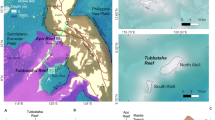Abstract
Extensive areas of methane-derived authigenic carbonate (MDAC) have been mapped in the Irish Sea. In the Irish Sector, 23 seabed mounds associated with the Codling Fault Zone were identified by multi-beam echo sounder mapping. Inspection by ROV-mounted video showed that these mounds are rocky features rising 5–10 m above the normal seabed; sampling showed that they are comprised of quartz grains bound together by carbonate cement, probably MDAC. Two separate locations have been mapped in the UK Sector. At Texel 11, seabed mounds and a 6–8 m high cliff were mapped geophysically (MBES, SSS and seismic profiler surveys). Video surveys showed that both the mounds and the cliff are rocky reefs colonised by a prolific fauna. Samples proved to be carbonate-cemented sediments, and carbon isotope analysis (δ13C −41 to −46% PDB) showed that the cement was MDAC. Similar surveys of the Holden’s Reefs area proved the presence of similar rocky reefs which are also cemented by MDAC. The total area covered by these two MDAC occurrences is estimated to be >500,000 m2. These MDAC occurrences are comparable in nature and formation to the ‘bubbling reefs’ of the Kattegat. As the bubbling reefs are “seabed features formed by leaking gas”, one of the marine habitats identified by the European Commission’s Habitats Directive as being sensitive and worthy of protection, it is suggested that the Irish Sea carbonate reefs should also be considered as special habitats.










Similar content being viewed by others
References
Boetius A, Ravenschlag K, Schubert CJ, Rickert D, Widdel F, Gieseke A, Amann R, Jørgensen BB, Witte U, Pfannkuche O (2000) A marine microbial consortium apparently mediating anaerobic oxidation of methane. Nature 407:623–626
Croker PF (1995) Shallow gas accumulation and migration in the western Irish Sea. In: Croker PF, Shannon PM (eds) The petroleum geology of Ireland’s offshore basins. Geol Soc Lond Spec Publ 93:41–58
Croker PF, Kozachenko M, Wheeler AJ (2005) Gas-related seabed structures in the Western Irish Sea (IRL-SEA6). January 2005 Tech Rep Strategic Environmental Assessment of the Irish Sea (SEA6), UK Department of Trade and Industry
EC (1999) Interpretation manual of European union habitats, version EUR 15/2. European Commission, Brussels
Hovland M, Judd AG (1988) Seabed pockmarks and seepages: impact on geology, biology and the marine environment. Graham and Trotman, London
Jackson DI, Jackson AA, Evans D, Wingfield RTR, Barnes RP, Arthur MJ (1995) The geology of the Irish Sea. BGS UK Offshore Regional Rep, HMSO, London
Jensen P, Aagaard I, Burke RA Jr, Dando PR, Jørgensen NO, Kuijpers A, Laier T, O’Hara SCM, Schmaljohann R (1992) ‘Bubbling reefs’ in the Kattegat: submarine landscapes of carbonate-cemented rocks support a diverse ecosystem at methane seeps. Mar Ecol, Prog Ser 83:103–112
Jones GB, Floodgate GD, Bennell JD (1986) Chemical and microbiological aspects of acoustically turbid sediments: preliminary investigations. Mar Geotechnol 6:315–332
Jørgensen NO (1976) Recent high magnesian calcite/aragonite cementation of beach and submarine sediments from Denmark. J Sediment Petrol 46:940–952 (freely available on journal webpage)
Judd AG (2001) Pockmarks in the UK sector of the North Sea. September 2001 Tech Rep Strategic Environmental Assessment of Parts of the North Sea (SEA2). UK Department of Trade and Industry
Judd AG (2005) The distribution and extent of methane-derived authigenic carbonate. March 2005 Tech Rep Strategic Environmental Assessment of the Irish Sea (SEA6). UK Department of Trade and Industry
Judd AG, Hovland M (2007) Seabed fluid flow: impact of geology, biology and the marine environment. Cambridge University Press, Cambridge
Pantin HM (1977) Quaternary sediments of the Northern Irish Sea. In: Kidson C (ed) The Quaternary history of the Irish Sea. Geol J Spec Issue 7:27–54
Tappin DR, Chadwick RA, Jackson AA, Wingfield RTR, Smith NJP (1994) The geology of Cardigan Bay and the Bristol Channel. British Geological Survey, London
Taylor Smith D (1987) Geotechnical studies in Tremadog Bay. Proc Geol Assoc 98:385–396
Wingfield RTR (1985) Isle of Man 54N 06W: seabed sediments and Quaternary geology. 1:250,000 Map Series, British Geological Survey
Yuan F, Bennell JD, Davis AM (1992) Acoustic and physical characteristics of gassy sediments in the Western Irish Sea. Cont Shelf Res 12:1124–1134
Acknowledgements
PAD surveys: PAD carried out a series of annual research surveys from 1995–2002 using the R/V Lough Beltra and later the R/V Celtic Voyager, under the direction of the second author. SEA6 surveys: Irish Sea campaign: geophysical surveys were conducted by OSAE (Offshore Survey and Engineering of Bremen, Germany) on the SV Meridian during August–September 2005. In October 2005, on SV Kommandor Jack, grab sampling of seabed sediments and water sampling were undertaken by ERT Ltd., and photographic surveys were performed by Seastar Ltd.; survey support was provided by OSAE. These surveys were directed by the first author. The parallel Tremadog Bay campaign was undertaken by a team from Osiris Projects Ltd. lead by the fourth author using the SV Lia. Scuba diving was undertaken by staff of the Countryside Commission for Wales; photographic surveys were by Seastar Ltd. Water samples and sediment porewaters were analyzed for methane by gas chromatography (GC-FID) at the University of Newcastle upon Tyne. Samples of the ‘hard-ground’ were inspected by scanning electron microscopy (SEM) at the University of Newcastle upon Tyne; carbon isotope analyses were performed by CF-IRMS by Iso-Analytical Ltd. Data were compiled for review and analysis using a geographical information system (ArcGIS). The SEA6 operations were managed by Geotek Ltd. on behalf of the UK Department for Trade and Industry. The authors gratefully acknowledge the contributions made by all the participants of these studies, including the captains and crews of the various vessels used: RV Celtic Voyager, SV Kommandor Jack, SV Lia, RV Lough Beltra, and SV Meridian.
Author information
Authors and Affiliations
Corresponding author
Rights and permissions
About this article
Cite this article
Judd, A., Croker, P., Tizzard, L. et al. Extensive methane-derived authigenic carbonates in the Irish Sea. Geo-Mar Lett 27, 259–267 (2007). https://doi.org/10.1007/s00367-007-0079-x
Received:
Accepted:
Published:
Issue Date:
DOI: https://doi.org/10.1007/s00367-007-0079-x




